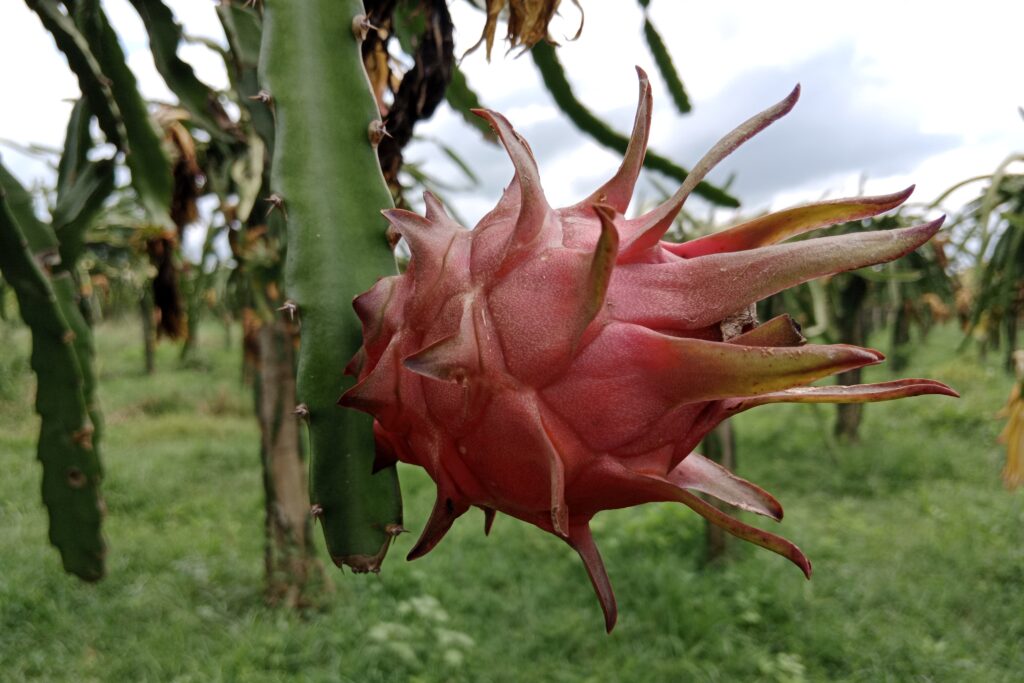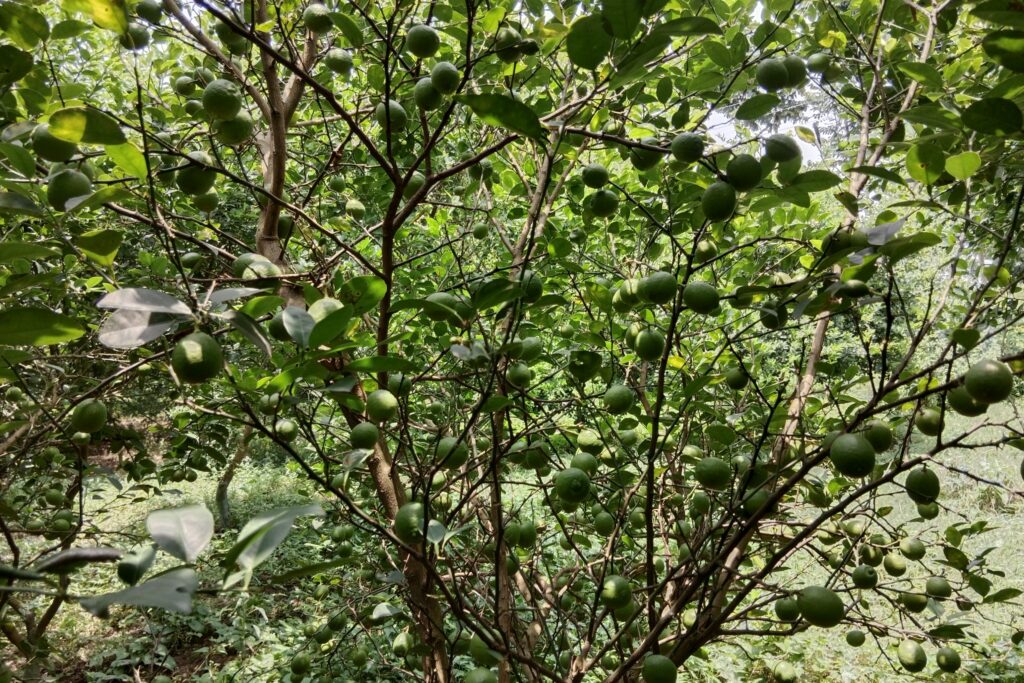Zucchini Farming
Zucchini (Cucurbita pepo) is a rapidly maturing summer squash that has gained importance as a profitable, high-yield crop with rising commercial value. Its short growth cycle and adaptability to diverse environments make it a reliable choice for farmers. With strong demand in local and global markets, zucchini provides excellent economic opportunities. Combined with its rich nutritional value, wide culinary uses, and modest input needs, it stands out as a sustainable and profitable option for modern agriculture.
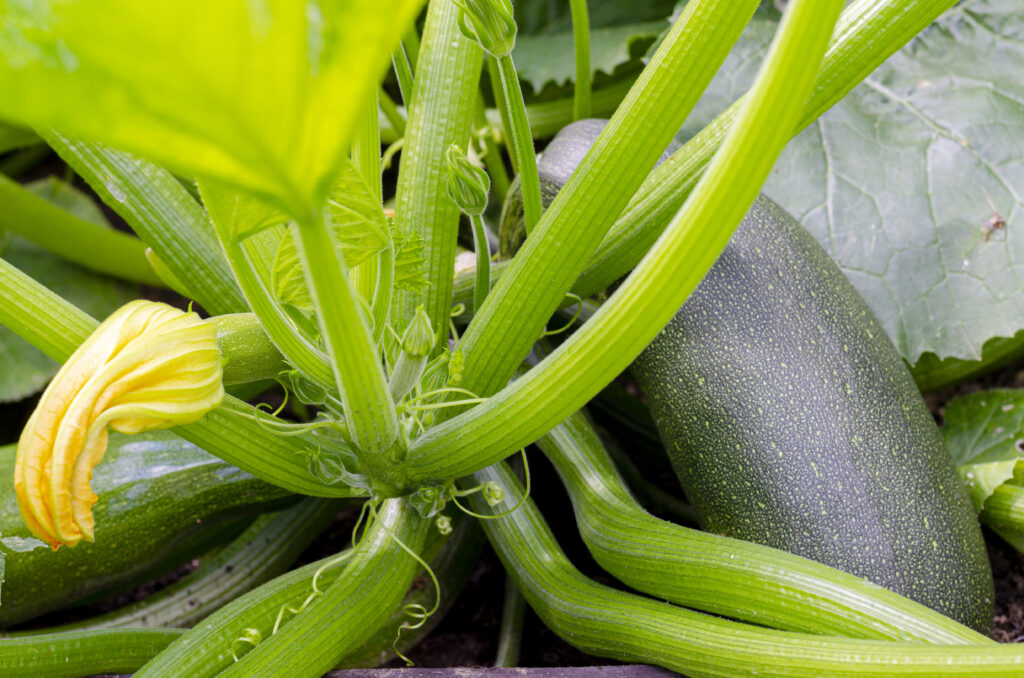
An analysis of zucchini farming profit per acre reveals it to be a highly lucrative cash crop, demonstrating remarkable financial potential for agricultural entrepreneurs. A detailed profitability analysis per acre shows a compelling economic outlook: with a total investment of approximately NRs. 56,000 covering all aspects of cultivation from land preparation to harvesting, this venture can generate an estimated income of NRs. 300,000.
This results in a substantial net profit of NRs. 244,000, reflecting an extraordinary 435.7% Return on Investment (ROI) and an impressive Benefit-Cost Ratio of 5.36, meaning every rupee invested yields a return of NRs. 5.36. These outstanding financial metrics underscore the exceptional viability of zucchini farming profit per acre and position it as an agricultural enterprise worthy of serious consideration for farmers seeking sustainable and profitable cropping alternatives.
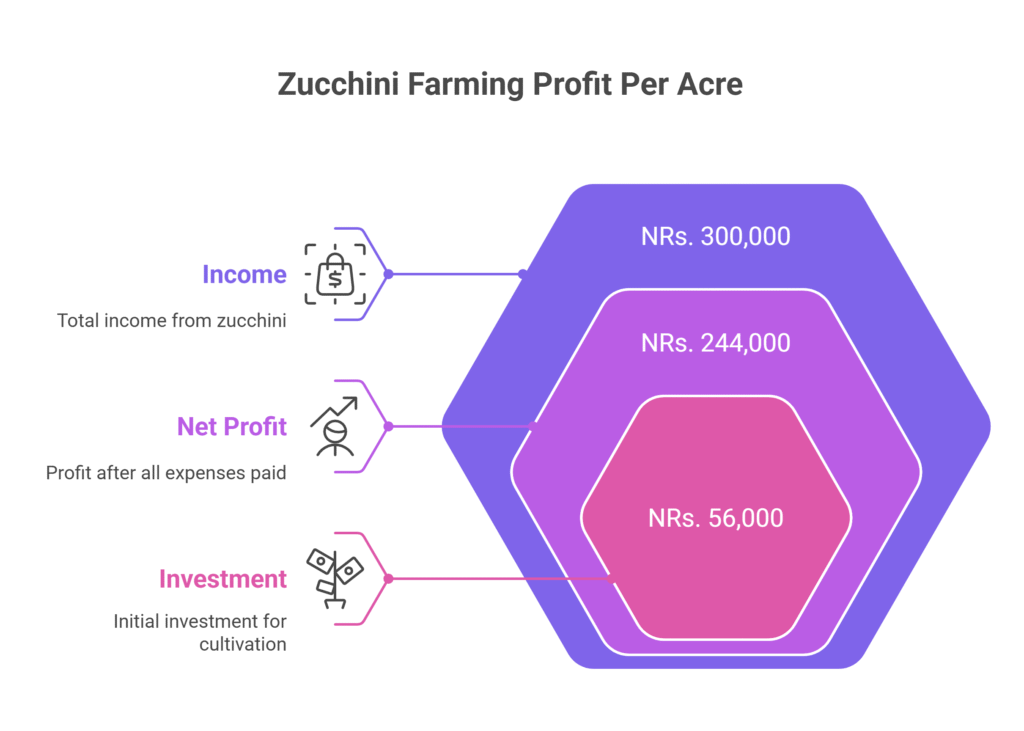
Land Preparation
The primary objective of land preparation is to establish an optimal environment for zucchini seeds or seedlings to thrive. A properly prepared field allows roots to expand easily, access nutrients, and ensures good water infiltration.
The process begins with first plowing, a critical initial step. Using a moldboard plow, the soil is turned over to a significant depth of 12-15 inches. This deep tilling is essential for breaking up any hardened layers of soil, known as hardpan, which can restrict root growth. It also effectively improves the overall structure and porosity of the soil, setting a strong foundation for the subsequent steps.
Following the first plowing, it is beneficial to allow the plowed soil to weather for approximately one week. This exposure to sun and wind helps to further break down soil clumps. After this period, the next step is harrowing. This involves performing 2-3 cross harrowings, meaning the field is worked in two different directions. This action is crucial for pulverizing the large clods of soil left from plowing, creating a finer tilth, and leveling the field surface for uniform water distribution.
An integral part of the final soil refinement is the incorporation of organic matter. During the last harrowing pass, well-decomposed Farm Yard Manure (FYM) or compost is evenly spread and mixed into the top layer of soil. This practice enriches the seedbed with essential nutrients, improves moisture retention in well-drained soils, and enhances microbial activity, providing a fertile growing medium for the zucchini plants.
Creating certain bed structures is the last step in land preparation. Raised beds or a system of ridges and furrows are highly suggested for zucchini. This design is essential because it allows for good drainage, which keeps water from collecting around the plant stems, which can cause rot and fungal diseases. Additionally, raised beds provide for stronger early development for this warm-season crop because they warm up faster in the spring sunlight.
Soil Type
The ideal growing conditions for zucchini are sandy loam to loamy soils that drain well and are high in organic matter. The best pH range for the crop’s growth is between 6.0 and 7.5, while it can withstand a wide range. Because they increase the danger of root infections and create waterlogging, heavy clay soils are not appropriate. It is advised to add sand or organic matter to poorly drained soils in order to improve drainage and soil texture.
Climatic Requirements
Zucchini is classified as a warm-season crop, meaning it thrives in warmer conditions and is sensitive to cold. Its ideal temperature range for active growth and development is between 18°C and 24°C (65°F to 75°F). This thermal range supports strong vine growth, flowering, and fruit set.
Successful cultivation begins with proper soil temperature. For seeds to germinate reliably and quickly, the soil must be warm, with temperatures consistently above 15.5°C (60°F). Cooler soils will lead to slow, poor germination or cause seeds to rot. It is crucial to note that growth is significantly stunted when temperatures drop below 10°C (50°F), and plants cannot survive a frost, which is fatal.
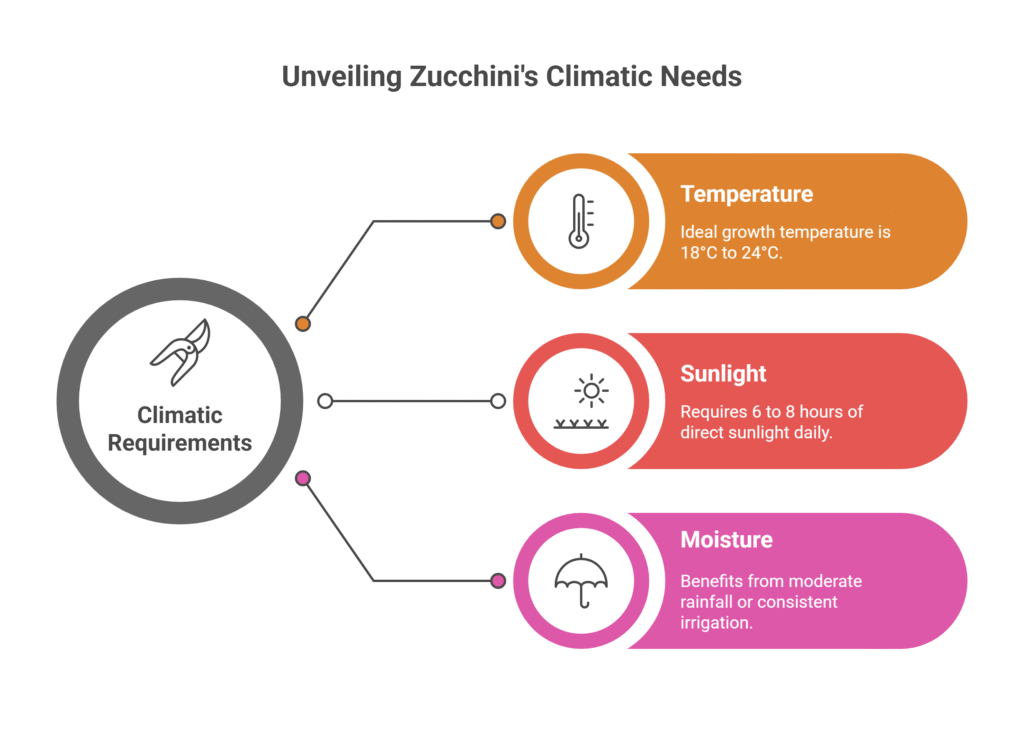
In addition to warmth, a lot of sunlight is necessary for zucchini to grow quickly and produce large quantities. The plants require 6 to 8 hours of unfiltered, direct sunshine every day at the very least. Enough sunlight is necessary to support photosynthesis, which makes plants stronger and encourages the abundant production of fruit and flowers.
In terms of moisture, zucchini benefits from moderate rainfall or consistent irrigation. However, prolonged periods of wet conditions, high humidity, or excessive leaf wetness are highly detrimental. These conditions create an ideal environment for powdery mildew and other fungal diseases to thrive. Consequently, zucchini tends to perform best in regions with a dry and warm climate.
Major Cultivars
Cultivars of zucchini are often selected based on key characteristics such as fruit color, which may range from dark green to light green or even yellow, as well as the shape of the fruit and their resistance to common diseases. Among the wide range of options available, several popular types are commonly favored by growers for their productivity, adaptability, and appealing appearance in the market.
| Cultivar | Characteristics |
| Black Beauty | Classic heirloom variety with dark green, cylindrical fruits. |
| Cocozelle | Striped, long, and tender fruits. |
| Golden Zucchini | Yellow-skinned variety with a shape similar to green types. |
| Aristocrat | Hybrid known for high yield and strong disease resistance. |
| Senator | Hybrid variety resistant to powdery mildew. |
| Eight Ball | Unique round, ball-shaped fruits. |
Propagation
Zucchini is propagated by seeds. While direct seeding is common, transplanting seedlings from a nursery is also practiced for an early harvest and better field establishment.
Seed Rate per Acre
The recommended seed rate for zucchini is about 1.0 to 1.5 kg per acre, though this may vary depending on seed size, germination rate, and plant spacing. To achieve good germination and reduce the risk of seed-borne diseases, it is advisable to use high-quality, treated seeds sourced from a reliable supplier.
Nursery Management
For transplanting, zucchini seeds are sown in small pots, cell trays, or pro-trays filled with a sterile seedling mix such as peat moss, vermiculite, or perlite, placing 2–3 seeds per cell at a depth of about 1 inch. The trays should be kept in a warm, protected environment like a greenhouse or polyhouse with consistent moisture to support germination.
Once seedlings emerge, thinning is done to retain only the strongest plant per cell. About 7–10 days before transplanting, seedlings are hardened off by gradually exposing them to outdoor conditions such as sunlight and wind to minimize transplant shock. Seedlings are typically ready for transplanting 3–4 weeks after sowing, once they have developed 2–3 true leaves.
Planting
a). Planting Season
In the plains, zucchini is mainly planted from February to March for the spring-summer crop, with a second crop possible during the post-monsoon season from September to October, while in the hilly regions, sowing is generally done from March to May.
b). Spacing
A common spacing is 1.5 meters between rows and 0.6 meters between plants within a row.
c). Pit Preparation
Dig pits of 30 cm x 30 cm x 30 cm at the recommended spacing.
d). Planting Method
Zucchini can be planted either by direct seeding or transplanting; in direct seeding, 2–3 seeds are sown per pit at a depth of 2–3 cm and later thinned to retain one healthy plant, while in transplanting, a healthy seedling is placed at the center of each prepared pit, covered with soil, and watered immediately.
e). Number of Plants per Acre
With a spacing of 1.5 m × 0.6 m, zucchini can be planted at a density of about 4,496 plants per acre.
Intercropping
Intercropping is a practical and beneficial practice in zucchini cultivation, particularly during the crop’s early growth stages. Suitable intercrops include short-duration vegetables such as radish, lettuce, or spinach, which can be harvested before zucchini plants fully mature, as well as legumes like bush beans that contribute to soil fertility by fixing nitrogen. However, it is advisable to avoid intercropping zucchini with other cucurbits, such as cucumber or melon, to minimize the risk of spreading common pests and diseases that affect plants within the same family.
Irrigation
Initial Irrigation
It is vitally important to water lightly as soon as seeds are planted or seedlings are moved into the garden. By settling the soil around the roots and removing air pockets, this first watering makes sure the young plant has instant access to the moisture it needs to recover from transplant shock and start establishing itself.
Critical Watering Stages
The flowering and fruit development phases are the most critical periods for consistent moisture. Any significant moisture stress during this time can disrupt the plant’s growth, leading to the abortion of flowers (flower drop) and the production of stunted or misshapen fruits, drastically reducing the harvest.
Recommended Irrigation Method
It is strongly advised to water zucchini with drips. Because water is delivered straight to the root zone, where it is most needed, this method is effective at conserving water. Keeping the plant’s foliage dry also has the important advantage of reducing the growth and spread of common fungal diseases like powdery mildew.
Watering Schedule
Watering deeply one or two times a week is the standard routine. Depending on your soil type (clay takes longer to drain than sandy soils) and the current weather (temperature, precipitation), you should modify the precise frequency. It is important to keep the soil continuously moist, like a wrung-out sponge, and to steer clear of both waterlogged and drought-stressed situations.
Fertilizer and Manure
Conducting a soil test is always the most reliable way to determine the exact nutrient requirements for optimal zucchini growth, as it provides precise recommendations based on the existing soil conditions. In the absence of a test, general fertilization guidelines per acre can be followed to ensure the crop receives adequate nutrients for healthy development and maximum yield.
Fertilizer Application Schedule for Zucchini
| Application Timing | Component | Details & Dosage |
| Basal Dose (During land preparation) | Well-rotted FYM or Compost | 15 – 20 tons per acre |
| Biofertilizer | 800 g per acre each of: • Azospirillum • Phosphorus Solubilizing Bacteria (PSB) • Potash Mobilizing Bacteria | |
| Primary Nutrients (N, P, K) | 40-50 kg Nitrogen (N) 50-60 kg Phosphorus (P₂O₅) 30-40 kg Potash (K₂O) (Can be applied using fertilizers like DAP) | |
| Top Dressing | Remaining Nitrogen | Apply the rest of the required N in 2-3 split doses using Urea or Calcium Ammonium Nitrate. • First dose: 30 days after planting. • Subsequent doses: At flowering and after the first harvest. |
Weed Control
Cultural Methods
Shallow hoeing and hand weeding are effective techniques for managing weeds in zucchini fields. The first weeding should typically be performed 2–3 weeks after planting to prevent competition with the young seedlings and promote healthy growth.
Mulching
Applying mulch, such as black plastic sheets or organic materials like straw and dried leaves, helps suppress weed growth, conserves soil moisture, and keeps the fruits clean by preventing direct contact with the soil.
Chemical Control
Pre-emergent herbicides, such as Pendimethalin, can be applied before weed seeds germinate to control weeds effectively. However, chemical use must be done with caution, strictly following the manufacturer’s instructions to avoid damage to the zucchini plants and the environment.
Interculture Operation
Zucchini plants are generally bush-type and do not need extensive training like vining crops. Regular pruning, which involves removing old, yellowing, or diseased leaves at the base, helps improve air circulation, reduce disease pressure, and allows the plant to channel its energy more effectively toward fruit production.
Flowering and Fruit Management
Zucchini plants are monoecious, meaning they produce separate male and female flowers on the same plant. Successful pollination, which is crucial for fruit development, relies heavily on the transfer of pollen from the male to the female blossoms. This task is primarily performed by bees and other pollinating insects, making their presence in the garden vital for a good harvest. Without their activity, the female flowers would simply wither and drop without producing fruit.
Several factors can lead to a poor fruit set, where flowers drop or fruits fail to develop properly. The most common cause is a lack of pollinators, often due to weather conditions, pesticide use, or simply an insufficient bee population in the area. Additionally, extreme temperatures—both excessive heat and cold—can interfere with pollen viability and insect activity. Moisture stress, either from drought or overwatering, can also cause the plant to abort its fruits as a survival mechanism.
In situations where natural pollinators are scarce, such as in greenhouses, on balconies, or during periods of cool, rainy weather, hand pollination is an effective and simple solution. This process involves identifying a freshly opened male flower (which has a plain stem) and a female flower (distinguished by a miniature fruit, or ovary, at its base). By gently brushing the pollen-laden stamen of the male flower against the central stigma inside the female flower, you can manually transfer the pollen and ensure the fruit develops.
To maintain a healthy and productive zucchini plant, it is essential to harvest the fruits regularly while they are still at an immature and tender stage, typically when they are 6 to 8 inches long. If fruits are left on the plant to become over-mature and seedy, the plant will divert a significant amount of its energy into ripening these few large fruits at the expense of producing new flowers. Consistent harvesting signals the plant to continue flowering and fruiting, thereby extending the overall bearing period and maximizing yield.
Pest and Disease Management
Common Pests
a) Fruit Fly (Bactrocera spp.)
Fruit flies are a significant pest, with females laying eggs under the skin of young fruits, leading to maggot infestation and fruit rot. Control requires an integrated approach. Use cultural practices like pheromone traps (e.g., 8-10 traps/acre with methyl eugenol or cue-lure) and bagging individual fruits. For chemical intervention, apply a bait spray or a targeted insecticide. A common recommendation is to spray Fipronil 5% SC at a dose of 1.5 – 2 ml per liter of water, ensuring thorough coverage of the fruit and foliage. Always adhere to the pre-harvest interval (PHI) specified on the label.
b) Aphids & Whiteflies
These sap-sucking insects weaken plants, cause leaf curling, and excrete honeydew that promotes sooty mold. They also act as vectors for viral diseases. Begin with biological controls by introducing natural predators like ladybugs or lacewings. Effective organic sprays include Neem Oil (apply at 2-3 ml per liter of water) or Insecticidal Soap (apply at 5-10 ml per liter of water). For severe infestations, a recommended chemical control is Acetamiprid 20% SP at a dose of 0.2 – 0.3 grams per liter of water, or Imidacloprid 17.8% SL at 0.3 – 0.5 ml per liter of water.
c) Squash Vine Borer (Melittia cucurbitae)
This moth’s larvae cause abrupt wilting and death of the plant by boring into the main stem. Early intervention and prevention are essential. Keep an eye out for entry holes and frass, which is excreted like sawdust, at the base of stems. Applying the beneficial nematode Steinernema carpocapsae directly into the afflicted stems with a syringe—usually in the range of 25,000 to 50,000 nematodes per plant, mixed with water—is the most efficient biological control method. Chlorantraniliprole 18.5% SC, applied at a dose of 0.3 to 0.4 ml per liter of water, can be used as a prophylactic soil drench at the base of plants during vine running.
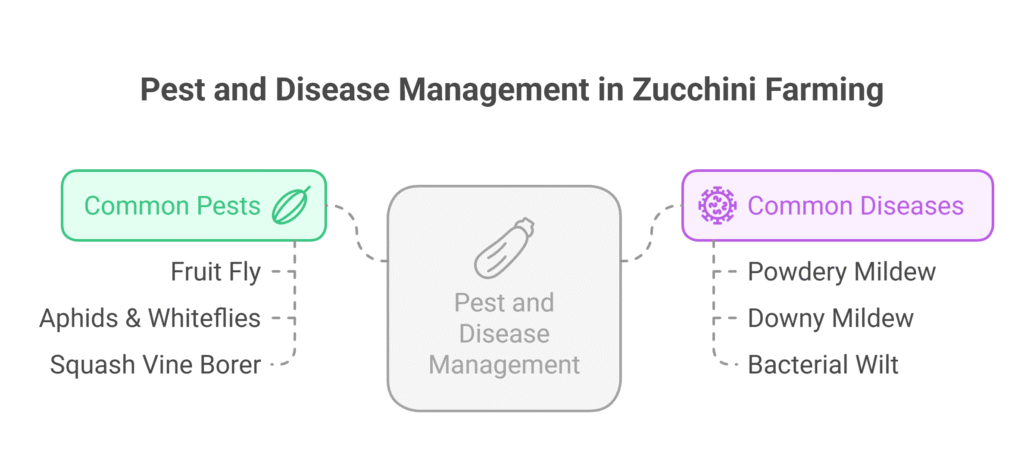
Common Diseases
a) Powdery Mildew (Podosphaera xanthii)
The distinctive white, powdery growth that develops on the upper and lower surfaces of leaves, eventually turning them yellow and withering, is a clear indicator of this fungal illness. Planting resistant types (like “Senator”) and making sure that plants are spaced properly to allow for enough air circulation are two important aspects of prevention.
Put 2-4 grams of wettable sulfur or 3-5 grams of potassium bicarbonate per liter of water in place for organic management. Systemic fungicides such as Azoxystrobin 23% SC (at 1 ml per liter) or Hexaconazole 5% SC (at 1-2 ml per liter) are very effective for more severe cases. As directed on the product label, always apply as soon as a disease symptom appears and repeat as needed.
b) Downy Mildew (Pseudoperonospora cubensis)
This water-mold disease, in contrast to powdery mildew, produces angular, yellow patches on the upper leaf surface that are bounded by the leaf veins. In humid conditions, the underside sometimes develops a fuzzy, grayish-purple growth.
Fungicides with a copper base are the norm. Two to three grams of copper oxychloride 50% WP should be added to each liter of water. Two to 2.5 grams of a fungicide, such as Metalaxyl 8% + Mancozeb 64% WP, can be added to one liter of water to increase systemic action. Make sure the leaves’ two sides are completely covered.
c) Bacterial Wilt (Erwinia tracheiphila)
This disease causes plants to wilt suddenly and collapse, often starting with a single stem. It is spread primarily by cucumber beetles, which carry the bacteria. There is no cure once a plant is infected; the primary strategy is to control the beetle vector.
Apply insecticides as a preventative measure when beetles are first spotted. Effective controls include Imidacloprid 17.8% SL (at 0.3-0.5 ml per liter) as a soil drench or Lambda-cyhalothrin 5% EC (at 1-1.5 ml per liter) as a foliar spray, targeting the cucumber beetles directly. Removing and destroying infected plants immediately is crucial to prevent further spread.
Harvesting
Timing the Harvest
Zucchini is known for its remarkably rapid growth. From the time of planting, fruits typically reach a harvestable stage very quickly, usually within 45 to 55 days. It is important to begin monitoring the plants closely as they approach this timeframe to ensure you pick the fruits at their peak quality.
Determining Harvest Readiness
When the fruits are young and soft, that is the best time to harvest them. A prime zucchini has a bright, glossy skin and measures about 6 to 8 inches (15 to 20 cm) in length. To check if the fruit is ready to be picked, lightly press your thumbnail against the skin. If it pierces easily, the fruit is ready. The rind of overripe fruits is hard and the skin is drab.
Proper Harvesting Technique
To harvest, use a sharp knife or a pair of pruning shears to cleanly cut the fruit from the main stem. It is crucial to leave a small piece of the stem (about an inch) attached to the zucchini. This stem acts as a protective barrier, significantly improving the fruit’s shelf life by reducing the risk of rot. Always handle the harvested fruits with care to prevent bruising, which can lead to rapid spoilage.
Importance of Harvest Frequency
Harvesting must be done often in order to maintain productivity. Every two to three days, you should inspect your plants and harvest ripe zucchini. By doing this, no fruit gets unduly big, harsh, or fibrous. More significantly, plucking the fruit on a regular basis tells the plant that it needs to produce more, which promotes a steady and plentiful output all through the growing season.
Yield
A well-managed zucchini farm can yield 8,000 to 12,000 kg per acre over the harvesting period.
Cost of Investment Per Acre for Zucchini Farming
| S.N. | Categories | Cost for Investment (NRs.) |
| 1 | Land Preparation | 15,000 |
| 2 | Seed | 2,000 |
| 3 | Nursery Management | 3,000 |
| 4 | Transplanting | 5,000 |
| 5 | Fertilizers and Manure | 9,000 |
| 6 | Irrigation | 5,000 |
| 7 | Weed Control (pre & post-emergence) | 3,000 |
| 8 | Pest & Disease Control | 3,000 |
| 9 | Harvesting | 6,000 |
| 10 | Miscellaneous Costs | 5,000 |
| Total Cost | 56,000 |
Income Per Acre from Zucchini Farming
| Yield Particulars | Estimated Yield / acre (Kg) | Market Price (NRs / kg) | Total Income (NRs.) |
| Total Yield | 10,000 | 30 | 300,000 |
Analysis of Zucchini Farming Profit Per Acre
Based on the tabulated data, here is a breakdown of the profitability.
| Description | Amount (NRs.) |
| Total Income | 300,000 |
| Total Investment | 56,000 |
| Net Profit | 244,000 |
Crop Calendar for Zucchini Farming
| Phase | Week | Key Activities | Agronomic Notes & Recommendations |
| Pre-Planting | -3 to -2 | Planning & Procurement. Secure seeds, FYM/compost, fertilizers, and irrigation setup. | Choose resistant cultivars (e.g., Aristocrat, Senator). Source high-quality, treated seeds. |
| -2 | Land Preparation. Perform first deep plowing (12-15 inches). | Allow plowed soil to weather for ~1 week to break down clods. | |
| -1 | Final Land Prep & Nursery Start. Perform cross harrowing, incorporate FYM/compost, form raised beds. Start nursery for transplanting. | Sow nursery seeds in trays. Ensure a fine tilth for good seed-soil contact. | |
| Planting (Week 0) | 0 | Planting. Direct seeding: Sow 2-3 seeds/pit. Transplanting: Move 3-4 week old seedlings to the field. Irrigate immediately. | Plains: Feb-Mar or Sep-Oct. Hills: Mar-May. Spacing: 1.5m x 0.6m. |
| Vegetative Growth | 1 | Crop Establishment. Ensure consistent moisture for germination/seedling establishment. | Light, frequent irrigations are critical. |
| 2-3 | Thinning & First Weeding. Thin direct-seeded plants to one/pit. Perform first manual weeding or hoeing. | Apply pre-emergence herbicide (e.g., Pendimethalin) if used, soon after planting. | |
| 3-4 | Fertilizer & Mulching. Apply first top-dressing of Nitrogen. Install mulch (plastic or organic). | Mulch conserves moisture, suppresses weeds, and keeps fruits clean. | |
| Flowering & Fruit Development | 5-6 | Flowering Initiation. Monitor for pests (aphids, whiteflies) and diseases (powdery mildew). Ensure pollination. | This is a critical irrigation stage. Encourage pollinators. Consider hand pollination if needed. |
| 6-7 | Fruit Set. Second top-dressing of Nitrogen. Intensify monitoring for fruit flies and vine borers. | Maintain consistent soil moisture to prevent flower drop and misshapen fruits. | |
| Harvest & Post-Harvest | 7-8 | First Harvest. Harvest begins ~45-55 days after planting. Pick fruits every 2-3 days at 6-8 inch size. | Use a sharp knife; leave a 1-inch stem attached to improve shelf life. |
| 8-14+ | Main Harvest Period. Continue frequent harvesting. Apply next top-dressing. Maintain pest/disease control. | Harvesting frequency is key to sustaining yield. Market produce promptly. | |
| 14+ | Field Clearance. After final harvest, remove and destroy all plant debris from the field. | This is a critical sanitation practice to break cycles of pests and diseases for the next crop. |
Sources
Food and Agriculture Organization (FAO)
University of California Agriculture & Natural Resources (UC ANR)
European Plant Protection Organization (EPPO)
Punjab Agricultural University (PAU)
Tamil Nadu Agriculture University (TNAU) – Agritech portal
Indian Council of Agricultural Research (ICAR)
Nepal Agricultural Research Council (NARC)
U.S. Department of Agriculture (USDA).
Ministry of Agriculture and Livestock Development (Nepal)
Disclaimer: This crop farming profits assume optimal conditions. Actual results may vary depending on climate, market prices, and farm management practices.

